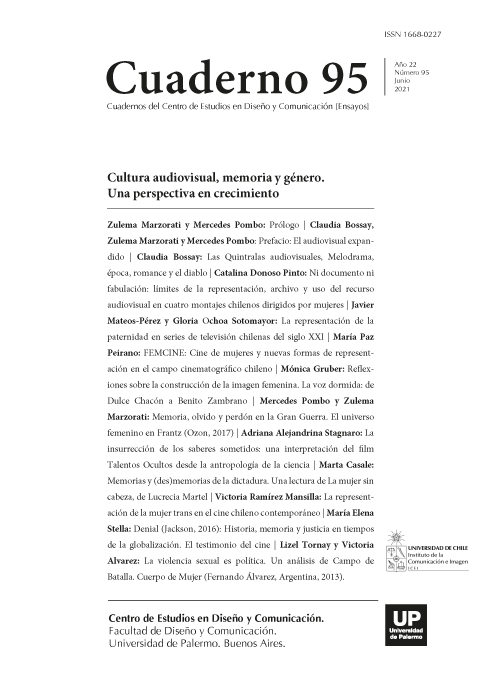Ni documento ni fabulación: límites de la representación, archivo y uso del recurso audiovisual en cuatro montajes chilenos dirigidos por mujeres
Abstract
Having in mind that theater and cinema have been related since the very origin of the latter, this article examines the associations between theatrical and cinematic staging in four Chilean plays where female directors are on charge: Cristo (2008), directed by Manuela Infante, Galvarino (2012), directed by Paula González, El año en que nací (2012), directed by Lola Arias and Especulaciones sobre lo humano (2017), directed by Ana Harcha. The analysis will be developed from the perspective of different authors that have addressed the intermediality of cinema and theater questioning the specificity of those languages and emphasizing its interrelation. The article will also consider other theoretical approaches coming from film theory that contribute to examine the relevance of technological images recorded and exhibited on stage.
References
Arnheim, R. (1996). El cine como arte. Barcelona: Paidós Ibérica.
Balázs, B. (1978). El film: Evolución y esencia de un arte nuevo. Barcelona: Gustavo Gili.
--- (2013). El hombre visible o la cultura del cine. Buenos Aires: El cuenco de plata.
Bazin, A. (2008). ¿Qué es el cine? Madrid: Rialp.
Bernini, E. (2012). “La indeterminación”. Jorge La Ferla y Sofía Reynal (comps.) Territorios audiovisuales. Buenos Aires: Libraria, pp. 295-310.
de Vicente, C. (2016). “El teatro en la realidad: once notas sobre el teatro documento”. Revista Artescena, no 2, 2016, pp. 34–45. Valparaíso: Universidad de Playa Ancha. Facultad de Arte.
Donoso, C. y Maturana, C. (2014). “Cine y teatro en los siglos XX y XXI en Chile: algunas aproximaciones a un cruce de lenguajes" (Co-autora). Travesías por el cine chileno y latinoamericano. Pp.73 -90. Santiago: LOM, Centro Cultural La Moneda Cineteca Nacional.
Einsenstein, S. (2003). La forma del cine. México, DF: Siglo XXI.
Gómez Tarín, F. (2003). Lo ausente como discurso: elipsis y fuera de campo en el texto cinematográfico. Valencia: Servicio de Publicaciones de la Universidad de Valencia.
Guasch, A. (2016). “El giro documental”. El arte en la era de lo global. 1989-2015. Madrid: Alianza, pp. 349-389.
Kristeva, J. (2013). “Bajtín, la palabra, el diálogo y la novela”, Critique, nº 239, abril de 1967. 440-441
Lehmann, Hans-Thies (2013). Teatro posdramático. Murcia: CENDEAC.
Jost, F. & Gaudreault, A. (1995). El relato cinematográfico: cine y narratología. Barcelona: Paidós.
Metz, C. (2001). El significante imaginario. Barcelona: Paidós.
--- (2002) Ensayos sobre la significación en el cine (1964-1968). Barcelona: Paidós.
Nichols, B. (1997). La representación de la realidad. Cuestiones y conceptos sobre el documental. Barcelona: Paidós.
Quiroga, H. (2007). “Teatro y cine”. Cine y literatura. Buenos Aires: Losada.
Reinelt, J. (2009). “The Promise of Documentary”. Get Real: Documentary Theatre Past and Present, editado por A. Forsyth y C. Megson, UK: Palgrave Macmillan, pp. 6–23.
Sontag, S. (1966). “Film and Theatre”, The Tulane Drama Review, Vol. 11, No. 1, pp. 24-37. Cambridge: MIT Press.
Volnovich, Y. (2012). “Actos de ver. La función documental”. Jorge La ferla y Sofía Reynal (Comps.) Territorios audiovisuales. Buenos Aires: Libraria, pp. 326-339.
Weiss, P. (1968). “El teatro de la realidad. Once notas sobre el teatro documento”. Revista Artescena N° 2, Noviembre 2018, pp. 34-45. Valparaíso: Universidad de Playa Ancha. Facultad de Arte.
Los autores/as que publiquen en esta revista ceden los derechos de autor y de publicación a "Cuadernos del Centro de Estudios de Diseño y Comunicación", Aceptando el registro de su trabajo bajo una licencia de atribución de Creative Commons, que permite a terceros utilizar lo publicado siempre que de el crédito pertinente a los autores y a esta revista.


